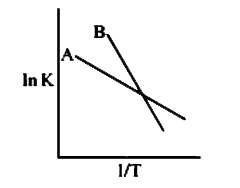At a certain temperature 'T',the endothermic reaction A→B proceeds virtually to the end. Determine.
(i) Signof ΔS for this reaction
(ii) sign of ΔS for the reaction B→A at the temperature T, and
(iii) the possibility of reaction B→A proceeding at a low temperature.
To solve the problem step by step, we will analyze the given endothermic reaction A→B and its implications on entropy (ΔS) and the reverse reaction B→A.
Step 1: Determine the sign of ΔS for the reaction A→B
1. Understanding Endothermic Reactions: An endothermic reaction absorbs heat from the surroundings. This typically results in an increase in disorder or randomness in the system.
2. Entropy Change: For the reaction A→B, if it proceeds virtually to completion, it suggests that the products (B) have a higher degree of freedom or disorder compared to the reactants (A).
3. Conclusion: Therefore, the sign of ΔS for the reaction A→B is positive (ΔS>0).
Step 2: Determine the sign of ΔS for the reaction B→A
1. Reverse Reaction: The reverse reaction B→A is simply the opposite of the forward reaction.
2. Entropy Change: Since we established that A→B has a positive ΔS, the reverse reaction B→A will have a negative entropy change.
3. Conclusion: Thus, the sign of ΔS for the reaction B→A is negative (ΔS<0).
Step 3: Analyze the possibility of the reaction B→A proceeding at a low temperature
1. Temperature Influence: The spontaneity of a reaction can be analyzed using the Gibbs free energy change (ΔG), which is given by the equation:
ΔG=ΔH−TΔS
where ΔH is the enthalpy change and ΔS is the entropy change.
2. For B→A:
- Since ΔS<0 for this reaction, the term −TΔS will be positive.
- If the reaction is exothermic (which is likely for B→A since A→B is endothermic), then ΔH<0.
3. Low Temperature Effect: At low temperatures, the TΔS term becomes small, and if ΔH is significantly negative, it can make ΔG negative, indicating that the reaction can proceed spontaneously.
4. Conclusion: Therefore, the reaction B→A can proceed at low temperatures, especially if it is exothermic.
Final Summary:
(i) Sign of ΔS for A→B: Positive (ΔS>0)
(ii) Sign of ΔS for B→A: Negative (ΔS<0)
(iii) Possibility of B→A proceeding at low temperature: Yes, it can proceed if it is exothermic.
2. Entropy Change: For the reaction A→B, if it proceeds virtually to completion, it suggests that the products (B) have a higher degree of freedom or disorder compared to the reactants (A).
2. Entropy Change: Since we established that A→B has a positive ΔS, the reverse reaction B→A will have a negative entropy change.
ΔG=ΔH−TΔS
where ΔH is the enthalpy change and ΔS is the entropy change.
- Since ΔS<0 for this reaction, the term −TΔS will be positive.
- If the reaction is exothermic (which is likely for B→A since A→B is endothermic), then ΔH<0.
(i) Sign of ΔS for A→B: Positive (ΔS>0)
(ii) Sign of ΔS for B→A: Negative (ΔS<0)
(iii) Possibility of B→A proceeding at low temperature: Yes, it can proceed if it is exothermic.
Similar Questions
Knowledge Check
- Question 1 - Select One
At a certain temperature T, the endothermic reaction A→B proceeds almost to completion.The entropy change is :
AΔS=0BΔS<0CΔS>0DCannot be predicted - Question 2 - Select One
What are the sign of ΔHandΔS for a reaction that is spontaneous only at low temperatures?
AΔH is positve, ΔS is positiveBΔH is positve, ΔS is negativeCΔH is negative, ΔS is negativeDΔH is negative, ΔS is positive - Question 3 - Select One
The signs of ΔH,ΔSandΔG for a non-spontaneous reaction at all temperature would e
A+,+,−B+,−,+C−,−,−D+,+,+
(a) An endothermicreaction A→B proceeds to completion . Predict the sign of ΔS.
(b) What will be the sign of ΔS for the reaction :N2(g)+O2(g)→2NO(g) ?
Given reasons in support of your answer.View SolutionAn endothermic reaction proceeds faster in the forward reaction with decrease in temperature.
View SolutionPredict the sign of ΔG for the reaction at a very low temperature for which ΔHis+ve and ΔS is positive.
View SolutionPlot ln K vs. 1/T for two reactions A and B are given below. Which reaction is more sensitive to temperature :-
 View Solution
View SolutionWhat are the signs of ΔH∘andΔS∘ for a reaction that is spontaneous at all temperature?
View Solution

